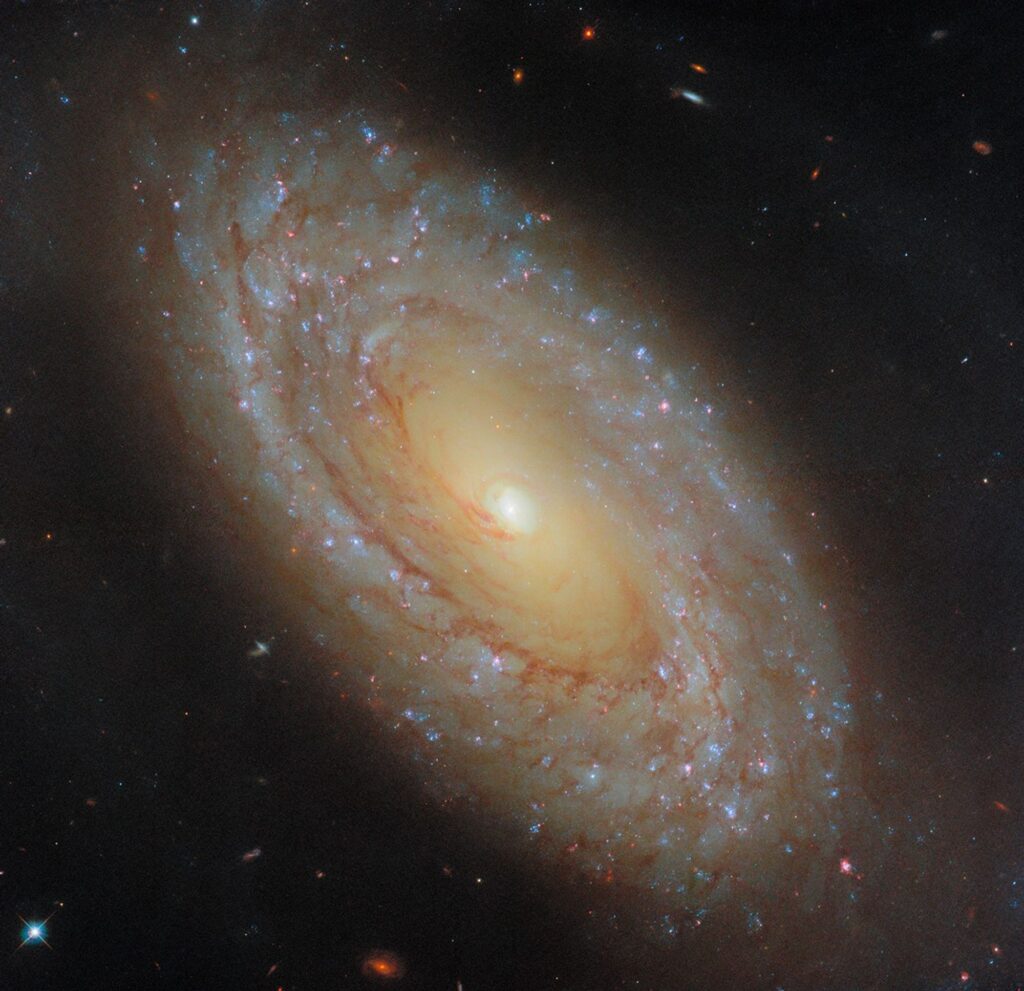
Introduction: What Makes NGC 4941 a Unique Galactic Laboratory?
The spiral galaxy NGC 4941, located approximately 67 million light-years from Earth in the constellation Virgo, is a compelling subject for astronomers. Thanks to the NASA/ESA Hubble Space Telescope, scientists can study this galaxy in extraordinary detail — observing individual star clusters, dense gas clouds, and the effects of a powerful central black hole.
NGC 4941 is not just another spiral galaxy. It’s a nearby, active system that provides a window into how galaxies form stars, evolve, and are shaped by both stellar and supermassive processes. This makes it an ideal case study for understanding the complex balance of cosmic forces at play.
NGC 4941 Through Hubble’s Lens
One of the primary reasons NGC 4941 is so valuable to astronomers is its proximity. Being relatively close on a cosmic scale allows Hubble’s advanced instruments to resolve intricate details within the galaxy — from bright star clusters to wispy clouds of interstellar dust.
The galaxy’s tightly wound spiral arms and prominent central bulge are classic features of a spiral galaxy, but it’s the internal processes — the birth of stars, their influence on the interstellar medium, and the activities of a central black hole — that captivate researchers.
Star Formation in NGC 4941: A Glimpse into Stellar Birth
NGC 4941 is actively forming new stars, primarily in dense regions of cold molecular gas known as stellar nurseries. These regions collapse under their own gravity, eventually igniting nuclear fusion and forming new stars.
Hubble’s observations reveal numerous such regions scattered throughout the galaxy’s arms. These young stars shine brightly and begin interacting with their environments almost immediately, setting off a chain of effects known as stellar feedback.
Understanding how stars form in galaxies like NGC 4941 helps astronomers build better models of star formation across the universe — from tiny dwarf galaxies to massive spiral and elliptical systems.
Stellar Feedback in NGC 4941: Stirring the Cosmic Pot
Once stars are born, they don’t remain quiet. Especially in the case of massive stars, stellar feedback plays a vital role in shaping the galactic environment. In NGC 4941, this feedback is visible in the form of energized gas clouds and disrupted dust structures.
Winds from young stars, intense radiation, and the shockwaves of supernova explosions all contribute to this feedback loop. These forces can both trigger new star formation by compressing gas or halt it by dispersing the raw materials needed to make stars.
In this NGC , studying the balance between these constructive and destructive effects gives scientists a better understanding of how galaxies regulate their own star formation rates.
The Active Galactic Nucleus of NGC 4941: A Powerful Core
At the heart of NGC 4941 lies more than just stars — it harbors an active galactic nucleus (AGN) powered by a supermassive black hole. As gas and dust spiral toward this black hole, they heat up and emit vast amounts of radiation across multiple wavelengths, from X-rays to infrared.
This AGN doesn’t just shine — it influences its entire host galaxy. Just like stellar feedback, the AGN in NGC 4941 sends out powerful winds and jets that reshape the galaxy’s internal structure. It can heat or even expel gas from the central regions, suppressing further star formation.
Hubble’s observations of this active nucleus help researchers understand how central black holes grow and how they impact their galaxies over millions of years.
Why NGC 4941 Is Key to Understanding Galaxy Evolution
Galaxies are not static entities. They grow, change, and interact with their surroundings over billions of years. This NGC, with both ongoing star formation and an active nucleus, represents a galaxy in a state of dynamic evolution.
Studying NGC offers key insights into questions like:
- How do galaxies control the rate at which they form new stars?
- What role do black holes play in regulating star formation?
- How does stellar feedback influence a galaxy’s structure and future?
By comparing galaxies like NGC 4941 to others at different stages of evolution, scientists can piece together the life stories of galaxies — including our own Milky Way.
NGC 4941 and the Virgo Constellation: A Cosmic Neighborhood
NGC 4941 resides in the Virgo constellation — a region of the sky rich with galaxies and cosmic structures. The Virgo Cluster, located nearby, contains thousands of galaxies and is one of the most massive known galaxy clusters in our local universe.
Though NGC 4941 is not a member of the central Virgo Cluster, its position in this densely populated region makes it especially interesting. Observing galaxies in such environments helps astronomers understand the influence of galactic neighbors and gravitational interactions on star formation and AGN activity.
How Hubble Enables Deep Studies
The Hubble Space Telescope, launched in 1990, has revolutionized our understanding of the cosmos. By capturing high-resolution images in visible and near-infrared light, it allows scientists to see galaxies like NGC 4941 with unprecedented clarity.
In the case of NGC 4941, Hubble’s imaging is part of a broader program to study star formation and stellar feedback in nearby galaxies. These data are critical for building accurate models of how stars form and how galaxies evolve over time.
As future missions like the James Webb Space Telescope (JWST) expand on this work, NGC 4941 will remain a cornerstone for comparative galactic research.
Conclusion:
NGC 4941 is far more than just a pretty spiral. It is a living, evolving galaxy — forming stars, interacting with its interstellar medium, and experiencing the powerful influence of a supermassive black hole.
Thanks to the Hubble Space Telescope, astronomers can dive deep into this galactic ecosystem and observe the fundamental processes that govern not only NGC 4941 but galaxies throughout the universe. From star formation to AGN feedback, this galaxy is a cosmic textbook — open and waiting to be read.
1 thought on “NGC 4941: Hubble Reveals Star Formation and Galactic Feedback”